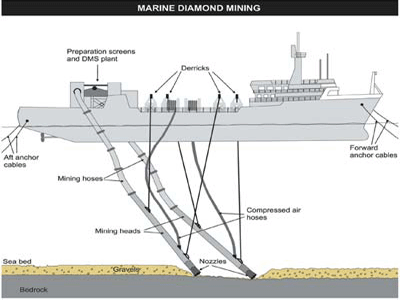Mining Marine Deposits
Marine deposits are a variant on alluvial deposits. They effect from the wave action of the ocean, which has concentrated diamonds at the base of the surf zone. Waves arriving at an angle to the coast tend to move forward the diamonds along the coast, causing the diamonds to stream out from where rivers deposited them at the coastline. Additionally, changes in climate have led to great variations in sea level -- hence movement of diamond concentrations to both old beaches well up on land and others now more than 100 meters below sea level.

There are 3 types of marine mining process. In one, sand is moved from 10 meters below sea level to as far inland as the sea may have risen, in order to disclose the concentrations on the bedrock. In another, divers and boats work in the surf zone to perhaps 20 meters of water and use suction pipes to take away gravel and diamonds from the ocean floor. In the third, deep-sea marine vessels use remote underwater tractors or large underwater excavators to take away overlying sediments and extract the diamond-bearing sand and gravel. Processing is done on land in the initial 2 cases and shipboard on the large mining vessels.
Wave refraction maps like this one for concession along the South African coast are used to help in locating concentrations of diamonds. The map shows where the wave force is maximized, and thus where diamonds will have been determined by wave action. Wave power is changed into the visible spectrum, so that blue represents weak and red strong power.
<< Back | Next >>